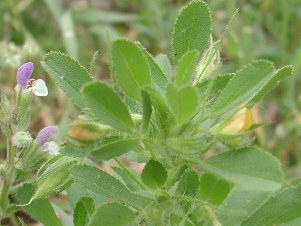Forage legume genetic resources
Contact person for Forage legume: Jean Hanson, ILRI, Ethiopia
Contributors to the section on best practices for management of forage legume genetic resources: ILRI, Ethiopia (Jean Hanson, Juvy B. Cantrell, Janice Proud); ICARDA, Syria (Ahmed Amri, Kenneth Street, Ali Shehadeh, Natalya Rukhkyan, Siham Asaad); GRCTPL, Australia (Richard Snowball); Bioversity International/ILRI, Addis Ababa, Ethiopia (Alexandra Jorge); CIAT, Cali, Colombia (Daniel Debouck, Maritza Cuervo).
External reviewer: Mark van de Wouw (Centre for Genetic Resources, The Netherlands)
|
An example of a forage legume (Ononis sicula) (photo: ICARDA) |
Compilation of best practices
Information on genebank management of forage legumes was gathered from current genebank practices, accumulated experience, literature and the websites of major forage genebanks (CIAT, ICARDA, ILRI, CSIRO-Australia, IGER-UK, USDA-Fort Collins, EMBRAPA-Brazil) and compiled into tables of procedures. This provided the basic information for selection, justification and recommendations that were then compiled, distinguishing information for seed banks and field banks. This information was finally uploaded into this website, complemented with relevant photos and revised and validated by the crop experts.
Importance and origin
Over 1500 species of legumes (from about a total of 17 000 legume species worldwide) can be used as feed for livestock, although only about 60 species have been developed and widely used as cultivated forages. The use of forage legumes is estimated to be as old as 11 000 years, with some species first being used as grain for human consumption and more recently only used for fodder or pasture, or vice versa (Mathison, 1983). Although tropical forage legumes have been grazed in natural habitats for many years, they have only been under cultivation for as little as 75 years, while some like Centrosema pubescens, Lablab purpureus and Pueraria javanica were used as cover crops and green manure at least a century earlier. Tropical legumes may have originated from tropical forests and natural grasslands and were later adapted to a variety of environments. Currently grasslands can be found from the tropics to the Arctic regions, from high rainfall regions to deserts and from rocky slopes and sand dunes to swamps (Williams, 1983).
Types of forage legumes
The wide range of species covers short-lived annuals to long-lived perennial trees and small herbaceous species to large woody species, adapted both to tropical and Mediterranean areas. Some Leguminosae are not used for forage due to their spines, thorns, woody characteristics or unpalatable or compounds poisonous to livestock (Mathison, 1983). Some plant stems and leaves have glands and glandular hairs or sticky exudates or aromatic compounds that sometimes can limit their utilization. With such a wide range of diversity, a broad range of methods are required for their management in genebanks. These general guidelines are only indicative and specific information should be sought in the literature whenever possible for species of interest.
Utilization
Forages legumes are mostly used as cut fodder or grazed pasture. Fodder may be fed directly to livestock or used after conservation as fermented green matter (silage and haylage) or dried for products like hay, pellets or cube concentrates. Pastures may be grazed directly or cut and used in feed rations for livestock. Legume crop residues and by-products are an important source of feed for livestock, allowing the grain to be used for human consumption as food–feed crops. Forages also have an important role in marginal areas in maintaining the natural resource base through soil stabilization, preventing soil erosion, and contribute to soil fertility through microbial nitrogen fixation and organic matter. Some forage legumes are also used to control leaching of nutrients in soils, as well as rotational crops to control pests and diseases of other crops.
References and further reading
Bogdan AV. 1977. Tropical Pasture and Fodder Plants, Longman, London, UK.
Cook BG, Pengelly BC, Brown SD, Donnelly JL, Eagles DA, Franco MA, Hanson J, Mullen BF, Partridge IJ, Peters M, Schultze-Kraft R. 2005. Tropical Forages: an interactive selection tool. (www.tropicalforages.info) CSIRO, DPI&F(Qld), CIAT and ILRI, Brisbane, Australia.
Fairey DT, Hampton JG, editors. 1997. Forage Seed Production, Volume 1: Temperate species. CABI publishing.
Loch DS, Ferguson JE, editors. 1999. Forage Seed Production, Volume 2: Tropical and subtropical species. CABI publishing.
Maas BL, Hanson J, Robertson LD, Kerridge PC, Moneim AE. 1997. Forages. In: Fuccillo D, Sears L, Stapleton P, editors. Biodiversity in Trust. Cambridge University Press. pp. 322-348.
McIvor JG, Bray RA, editors. 1983 Genetic Resources of Forage Plants. CSIRO, Melbourne, Australia.
Skerman PJ, Cameron DG, Riveros F. 1988. Tropical Forage Legumes, FAO Plant Production and Protection Series, no. 2. Food and Agriculture Organization of the United Nations, Rome, Italy.
Williams RJ. 1983. Tropical legumes. In: McIvor JG, Bray RA, editors. Genetic resources of forage plants. CSIRO, Australia. pp. 17-37.
Comments
- No comments found



 Forage legumes
Forage legumes

Leave your comments
Post comment as a guest